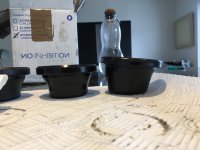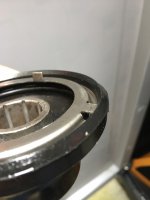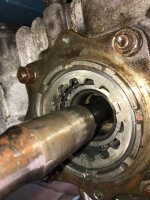You are using an out of date browser. It may not display this or other websites correctly.
You should upgrade or use an alternative browser.
You should upgrade or use an alternative browser.
Technical Rear transmission
- Thread starter dk500
- Start date
Currently reading:
Technical Rear transmission
Is lithium based molybdenum grease ok on the coupling ?
I believe that is exactly the right thing. I have a spare sachet of CV-joint grease which I use for things like that. Be generous with it and don't consider it done for life. The joints benefit from regular re-packing. If you slip back the rubber and slop some grease under it whenever you grease the kingpins it wil help.
dk500
Member
- Joined
- Aug 17, 2013
- Messages
- 260
- Points
- 53
Hi
Managed to fit the flexible couplings and do the weight test. Both seem ok.
However my second job of replacing the oil boots that are leaking, not so good !
Took off one side and replaced with new boot as the old one is starting to perish.
However I cannot get it to fit correctly.
In all the fumbling the "adjuster lock ring" popped out, I replaced but unsure if this has to fitted in a particular way or just pop back in ?
The parts are from A Gerstl, so I am hoping they are ok.
I cannot even refit the old one !
Frustration ! Currently dripping away on the driveway.
Any advice or tips on where to go from here and fit correctly .
Thanks
Managed to fit the flexible couplings and do the weight test. Both seem ok.
However my second job of replacing the oil boots that are leaking, not so good !
Took off one side and replaced with new boot as the old one is starting to perish.
However I cannot get it to fit correctly.
In all the fumbling the "adjuster lock ring" popped out, I replaced but unsure if this has to fitted in a particular way or just pop back in ?
The parts are from A Gerstl, so I am hoping they are ok.
I cannot even refit the old one !
Frustration ! Currently dripping away on the driveway.
Any advice or tips on where to go from here and fit correctly .
Thanks
Last edited:
Paolo66
Established member
- Joined
- Feb 6, 2013
- Messages
- 1,004
- Points
- 235
Just stripped my drive shafts tonight. There should be 4 lugs that locate in the bearing lock ring. Mine where fitted 0, 90, 180 & 270 degrees but I dont think it matters. I am modernising my oil boots as the oil seal that was in there was too hard a material in my opinion. I have ordered some SKF viton ones and am hoping these will be a better fit on the shaft. Only time will tell but it certainly wont be as bad as the ones that where on there.
Darryl, I think you're worrying unnecessarily. The bit that dropped out will be the lock-ring; it's the adjuster ring inboard of that which mustn't move. It will have so much friction that it would be hard to simply budge it like that. The biggest risk comes when the carrier that it's in is unbolted and the whole assembly is put back in the wrong orientation.
I've found it tricky to do what you're attempting. The turned edge of the boot has to sit over that loose lock-ring and then whilst you hold the whole thing against the gearbox you have to guide the pressed steel cirumference retainer over it.
It is possible that the rubber boot has been moulded too small or large.......do you have a photo?
I've found it tricky to do what you're attempting. The turned edge of the boot has to sit over that loose lock-ring and then whilst you hold the whole thing against the gearbox you have to guide the pressed steel cirumference retainer over it.
It is possible that the rubber boot has been moulded too small or large.......do you have a photo?
Paolo66
Established member
- Joined
- Feb 6, 2013
- Messages
- 1,004
- Points
- 235
I am really hoping that the lock ring being moved does not put me in a hole :-(
It wont. 2 tabs locate in the bearing ring and 2 locate in the housing. This means the nut cant turn relative to the housing. As long as you have only removed the oil boots you'll be fine.
dk500
Member
- Joined
- Aug 17, 2013
- Messages
- 260
- Points
- 53
Thanks for the reassurance, I will post some photos later, I don't think they are too dissimilar. As I said I couldn't even refit the old boot, I think my frustration got the better of me.
You are probably right, it is just very awkward while lying under the car.
You are probably right, it is just very awkward while lying under the car.
I had put the ring in its place and tried fitting boot and retainer, should I put the ring into the boot first ?
Will the tabs slip into place ok ?
That might work...worth a try. I have a part stripped box in thg garage so I will look into what might be wrong from a practical point of view.
Just thinking back, does the boot butt up to the lip containing the slip ring or should the rubber lip go around that metal lip ?
It looks easiest to put the lip over the slip-ring, put the retainer over that and then hold the assembly against the casing to locate the tabs into the adjuster slots. You may need to turn it a little to align everything.
The images are of an original boot fresh from a storage box.
 MAL_4815 by Peter Thompson, on Flickr
MAL_4815 by Peter Thompson, on Flickr MAL_4816 by Peter Thompson, on Flickr
MAL_4816 by Peter Thompson, on Flickr MAL_4817 by Peter Thompson, on Flickr
MAL_4817 by Peter Thompson, on FlickrI am presuming the flat tabs need to fit in the gaps in the outer ring where the red dot is and the protruding tab into the teeth of the inner ring of teeth
That's correct, but any of the tabs can go in any of the slots; it doesn't have to be the one marked red. There may be several orientations that will fitand then just spin the retainer until it aligns with the mounting hole.
dk500
Member
- Joined
- Aug 17, 2013
- Messages
- 260
- Points
- 53
Hi Peter, your advice as always worked a treat, checked the correct tab position and followed your instructions. I had the boots replaced in fairly quick time for a complete novice !
I took him for a quick spin and the rear right hub was giving a bit of a rumbling noise. I had noticed this while doing the Haynes weight test.
I have tightened that hub up a little more until the rumbling was gone, there does not appear to be any other unwanted sounds !
This hub does feel slightly less free to turn !
I imagine it is the bearings on the way out ?
Am I causing further complications by tightening it up and do you think it is a job I could leave on the long finger ?
Anything to look out for if I leave this set up as it is ?
I took him for a quick spin and the rear right hub was giving a bit of a rumbling noise. I had noticed this while doing the Haynes weight test.
I have tightened that hub up a little more until the rumbling was gone, there does not appear to be any other unwanted sounds !
This hub does feel slightly less free to turn !
I imagine it is the bearings on the way out ?
Am I causing further complications by tightening it up and do you think it is a job I could leave on the long finger ?
Anything to look out for if I leave this set up as it is ?
I'm glad you got all that sorted,
I seem to be in a minority regarding the rear hub tightening, as I am convinced of the need to properly reset the turning torque of the hub every time the nut is loosened. Some people consider that just nipping it up is fine, especially when it was previously OK. Some argue that the spacer is not needed and that it can be setup just like the front hubs.
The spacer is trapped between the inner rings of the two bearings and as the hub nut is tightened, the rings and hence the tapered rollers which they bear against, are progressively forced against the spacer from each side. The spacer is very strong but designed to start to collapse under increasing load. At the point at which the torque on the nut has pushed the bearings together to achieve the correct turning load on the bearing, the spacer is able to exert a force equal to that applied on the nut. It will maintain this preload keeping the bearings under the perfect load conditions until they wear out. If you overtighten the bearings or randomly retighten without checking the rotational torque on the hub, the bearings may be overloaded or too loose. Apart from anything else, if too loose or missing the spacer or overloaded, they will not operate as a unified pair and in addition to accelerated wear this can lead to handling problems including imprecise steering.
To cut this long sermon short, I would get a couple of rear bearing kits in stock so you can replace them if the noise gets intrusive or handling starts to suffer or if your MOT-person fails them or gives an advisory.
I seem to be in a minority regarding the rear hub tightening, as I am convinced of the need to properly reset the turning torque of the hub every time the nut is loosened. Some people consider that just nipping it up is fine, especially when it was previously OK. Some argue that the spacer is not needed and that it can be setup just like the front hubs.
The spacer is trapped between the inner rings of the two bearings and as the hub nut is tightened, the rings and hence the tapered rollers which they bear against, are progressively forced against the spacer from each side. The spacer is very strong but designed to start to collapse under increasing load. At the point at which the torque on the nut has pushed the bearings together to achieve the correct turning load on the bearing, the spacer is able to exert a force equal to that applied on the nut. It will maintain this preload keeping the bearings under the perfect load conditions until they wear out. If you overtighten the bearings or randomly retighten without checking the rotational torque on the hub, the bearings may be overloaded or too loose. Apart from anything else, if too loose or missing the spacer or overloaded, they will not operate as a unified pair and in addition to accelerated wear this can lead to handling problems including imprecise steering.
To cut this long sermon short, I would get a couple of rear bearing kits in stock so you can replace them if the noise gets intrusive or handling starts to suffer or if your MOT-person fails them or gives an advisory.
Paolo66
Established member
- Joined
- Feb 6, 2013
- Messages
- 1,004
- Points
- 235
You are correct Peter. However there are a couple of issues mainly by modern replacement parts. The spacer is nowhere near compressible as it should be. If your spacer comes longer than the gap between the bearings (as it should do) then you end up with the horror stories of people lifting their cars off the axle stands as they try to compress it using a scaffold pole for a lever. If it comes too short then you will get the rotational torque you need but the spacer wont be touching the bearings. I did think about replacing mine with a spring which you could reuse time again.
Similar threads
- Replies
- 8
- Views
- 208
- Replies
- 0
- Views
- 73






